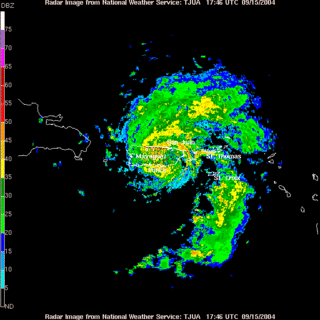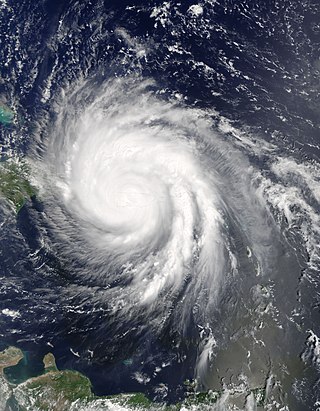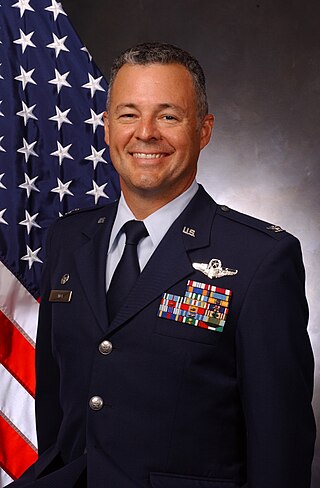Related Research Articles

Hurricane Hugo was a powerful tropical cyclone that inflicted widespread destruction across the northeastern Caribbean and the Southeastern United States in September 1989. The eleventh tropical cyclone, eighth named storm, sixth hurricane, and second major hurricane of the 1989 Atlantic hurricane season, Hugo arose from a cluster of thunderstorms near Cape Verde on September 10, 1989. This cluster coalesced into a tropical depression and strengthened into Tropical Storm Hugo as it tracked west across the Atlantic Ocean for several days. On September 13, Hugo became a hurricane and continued to intensify though September 15 when its sustained winds peaked at 160 mph (255 km/h), making it a Category 5 hurricane on the Saffir–Simpson scale. Between September 17 and 21, Hugo made landfall on Guadeloupe, Saint Croix, Puerto Rico, and lastly South Carolina, with major hurricane strength winds. The storm weakened inland and accelerated north over the Eastern United States, transitioning into an extratropical cyclone on September 23 before it was last noted in the far northern Atlantic on September 25.

Southern California Edison (SCE), the largest subsidiary of Edison International, is the primary electric utility company for much of Southern California. It provides 15 million people with electricity across a service territory of approximately 50,000 square miles.
National Grid plc is a British multinational electricity and gas utility company headquartered in London, England. Its principal activities are in the United Kingdom, where it owns and operates electricity and natural gas transmission networks, and in the Northeastern United States, where as well as operating transmission networks, the company produces and supplies electricity and gas, providing both to customers in New York and Massachusetts.

The Edison Electric Institute (EEI) is an association that represents all U.S. investor-owned electric companies.

The effects of Hurricane Georges in Puerto Rico included $2 billion in damages and five fatalities. Hurricane Georges was the first hurricane to cross the entire island since the San Ciprian Hurricane in 1932. Georges formed on September 15 as Tropical Depression Seven off the African coast. Georges strengthened into a Category 4-hurricane on September 19 as it made landfall in the Lesser Antilles. Georges made landfall on the island on September 21 as a Category 3-hurricane. Georges caused $3 billion in damage to the island.

Kyle Datta, named to the Puerto Rico Electric Power Authority Transformation Advisory Council. The Puerto Rico Electric Power Authority (PREPA) announced the names of 11 utility industry leaders who will serve as founding members of PREPA's Transformation Advisory Council (TAC). The TAC was formed to provide PREPA's Governing Board and management team with advice on the development of a long-term vision and transformation execution plan for the power system in Puerto Rico. the TAC consist of recognized executive leaders from the public power and investor owned utility sector and from select non-governmental organizations. Collectively, the TAC members are experts in grid reliability and resilience, corporate restructuring, sustainability, island grids, public power, customer engagement, evolving regulatory frameworks for distributed energy resources, and the utility of the future. Mr. Datta has overseen the development of PREPA's most recent IRP which was released in draft form and calls for 2,000 MW of Solar PV and 1,000 MW of Battery Energy Storage along with a groundbreaking mini grid design to create a resilient energy system.

DP&L Inc. is a subsidiary of AES Corporation. Through its subsidiaries The Dayton Power and Light Company and DPL Energy Resources, DP&L sells to, and generates electricity for, a customer base of over 500,000 people within a 6,000-square-mile (16,000 km2) area of West Central Ohio, including the area around Dayton, Ohio, its namesake. Electricity for DP&L's 24 county service area within Ohio's Miami Valley is primarily generated at eight coal-fired power plants, but DP&L also provides service to its clients via the use of combustion turbines, diesel peaking units, and solar powered properties.
Sunrun Inc. is an American provider of photovoltaic systems and battery energy storage products, primarily for residential customers. The company was established in 2007 and is headquartered in San Francisco, California.

Oncor Electric Delivery Company is the largest transmission and distribution electric utility in the state of Texas and the 5th largest utility company in the US. Their service territory includes east, west, and north-central Texas, including Dallas, Fort Worth, Irving, Plano, Arlington, Beeville, Midland, Odessa, Killeen, Waco, Wichita Falls, Tyler, and other cities throughout Texas. In 2018, Sempra Energy acquired a majority stake in Oncor for US$9.45 billion.
Antonio S. Lucchetti was a Puerto Rican engineer and public servant, through whom comprehensive electric service was established in Puerto Rico via the Puerto Rico Water Resources Authority (PRWRA) and, later, via the public electric company, Fuentes Fluviales.

Green Puerto Rico is an umbrella term used to describe a pair of sustainable and renewable energy reforms that were signed into law on July 19, 2010 by Luis Fortuño during his governance of Puerto Rico. Two principle policies were developed in an effort to improve the Puerto Rican economy and to protect the environment. The first was aimed at decreasing Puerto Rico’s energy dependence on fossil fuels and increasing the development and ultimate use of renewable energy sources. This policy is titled Public Policy on Energy Diversification by Means of Sustainable and Alternative Renewable Energy in Puerto Rico Act. The second policy focuses on long-term economic savings and is titled the Green Energy Incentives Act of Puerto Rico. Both acts were designed to foster development and use of renewable energy sources to replace non-renewable energy sources such as oil. Energy policy in Puerto Rico has traditionally emphasized oil, but has made some strides over the last two decades with Green Puerto Rico which is an important step towards development and implementation of renewable energy in Puerto Rico.

The effects of Hurricane Jeanne in Puerto Rico included the most damage from a tropical cyclone since Hurricane Georges in 1998. The tenth tropical storm of the 2004 Atlantic hurricane season, struck the U.S. territory of Puerto Rico on September 15 with 70 mph (110 km/h) winds. While crossing the island, the storm dropped heavy rainfall, peaking at 19.2 in (490 mm) at Aibonito, with a total of 23.75 in (603 mm) on the offshore island of Vieques. The rainfall caused widespread flooding, resulting in landslides and heavy crop damage. Winds reached 72 mph (116 km/h) at Cayey, and its combination with the rainfall left most of the island without power or water.

The Puerto Rico Electric Power Authority Is an electric power company owned by the Commonwealth of Puerto Rico responsible for electricity generation, power distribution, and power transmission on the island. PREPA was the only entity authorized to conduct such business in Puerto Rico, making it a government monopoly, until on January 22, 2018, former governor of Puerto Rico, Ricardo Rossello, announced that all assets of the company will be sold in a general privatization of PREPA.
The Puerto Rico Energy Bureau is the government agency that regulates the energy industry in Puerto Rico. The commission was created with the primary intention of regulating the Puerto Rico Electric Power Authority (PREPA): the government-owned corporation and government monopoly that distributes and transmits all energy in Puerto Rico as well as producing 70% of all energy in Puerto Rico. Before the commission came into existence, PREPA regulated both itself and the energy industry without any oversight whatsoever. As renewable energy became economically feasible, Puerto Rico lagged behind in comparison to other jurisdictions. This did not bode well with several energy businesses and think tanks, such as the Association of Producers of Renewable Energy (APER) and the Center for the New Economy (CNE), which advocated for the creation of a separate independent entity capable of regulating the industry.

Hurricane Maria was a deadly Category 5 hurricane that devastated the northeastern Caribbean in September 2017, particularly in the U.S. territory of Puerto Rico, which accounted for 2,975 of the 3,059 deaths. It is the deadliest and costliest hurricane to strike the island of Puerto Rico, and is the deadliest hurricane to strike the country of Dominica and the territory of the U.S. Virgin Islands. The most intense tropical cyclone worldwide in 2017, Maria was the thirteenth named storm, eighth consecutive hurricane, fourth major hurricane, second Category 5 hurricane, and deadliest storm of the extremely active 2017 Atlantic hurricane season. Maria was the deadliest Atlantic hurricane since Mitch in 1998, and the tenth most intense Atlantic hurricane on record. Total monetary losses are estimated at upwards of $91.61 billion, mostly in Puerto Rico, ranking it as the fourth-costliest tropical cyclone on record.

Between September 19–21, 2017, Hurricane Maria devastated the entire island of Puerto Rico and caused a major humanitarian crisis. Originally as a powerful Category 5 hurricane, Maria was the strongest storm to impact the island in nearly 90 years. Maria made landfall on Puerto Rico on September 20 as a high-end Category 4 storm, bringing a large storm surge, very heavy rains, and wind gusts well above 100 mph (160 km/h). It flattened neighborhoods, crippled the island's power grid, and caused an estimated 2,982 fatalities and US$90 billion in damage.

Hurricane Maria struck Puerto Rico as a high-end Category 4 hurricane on September 20, 2017, resulting in the island's most severe natural disaster in modern history. The entire island suffered devastating effects with the entire population losing access to electricity, the majority losing access to clean water, tens of thousands of homes destroyed, and road infrastructure left crippled. A series of cascading infrastructure failures compounded the direct effects of the hurricane. Lack of aid, electricity, water, and access to medical care endangered many people; elderly and poor residents were most impacted.

Colonel Noel Zamot is a retired United States Air Force officer who was the first Hispanic Commandant of the Air Force's elite Test Pilot School. Zamot is a former combat and test aviator with over 1900 hours in B-52, B-1B, B-2A, F-16D and over 20 other aircraft. He created the first system for testing complex military systems in contested cyberspace for the United States. Zamot is also the founder of Corvus Analytics, a consulting firm which helps its clients to design and develop cyber resiliency for complex systems.

LUMA Energy is a private power company that is responsible for power distribution and power transmission in the Commonwealth of Puerto Rico. They are also in charge of maintaining and modernizing the power infrastructure. Previously, these duties belonged exclusively to the Puerto Rico Electric Power Authority, but as of July 20, 2018, permission was granted for PREPA assets and service duties to be sold to private companies, and on June 22, 2020, a 15-year contract with LUMA was signed, making LUMA the new operator. The takeover took place on June 1, 2021.
References
- ↑ "Whitefish Energy Holdings, LLC Statement on Agreement with Puerto Rico Electric Power Authority (PREPA)". www.prnewswire.com. Retrieved 2018-07-10.
- 1 2 3 Robles, Frances (November 12, 2017). "The Lineman Got $63 an Hour. The Utility Was Billed $319 an Hour". New York Times. Retrieved November 13, 2017.
- ↑ Mosier, Jeff (27 October 2017). "Dallas money fuels Whitefish, a tiny Montana firm under scrutiny for $300M Puerto Rico contract". Dallas News. Retrieved 30 October 2017.
- ↑ Weill, Kelly (October 24, 2017). "Trump-Connected Company Hired to Fix Puerto Rico Has Only Worked Two Federal Jobs". The Daily Beast .
- 1 2 3 4 5 Mufson, Steven; Gillum, Jack; Davis, Aaron; Hernández, Arelis (October 23, 2017). "Small Montana firm lands Puerto Rico's biggest contract to get the power back on". The Washington Post .
- 1 2 Scurria, Andrew (October 27, 2017). "FEMA Raises Concerns Over Puerto Rico Power Grid Contract". The Wall Street Journal .
- ↑ C. Davis, Aaron (October 27, 2017). "FEMA cites 'significant concerns' over Whitefish Energy deal in Puerto Rico". Washington Post .
- ↑ Gonzalez, Joanisabel (October 27, 2017). "FEMA niega su rol en la contratación de Whitefish". El Nuevo Día (in Spanish).
- ↑ Bowden, John (October 27, 2017). "Whitefish Energy contract bars government from auditing deal". The Hill .
- ↑ Wamsley, Laurel (October 27, 2017). "Here's What's In That $300 Million Whitefish Contract". NPR .
- ↑ Borak, Donna (October 25, 2017). "San Juan's mayor takes on small Montana firm over Puerto Rico power contract". CNN .
- ↑ "'Days were lost': Why Puerto Rico is still suffering a month after Hurricane Maria". The Miami Herald. October 19, 2017.
- ↑ Dooley, Erin; Ebbs, Stephanie; Hoyos, Joshua (October 27, 2017). "Lawmakers asking why small Montana business landed $300M Puerto Rico power restoration contract". ABC News .
- ↑ Borak, Donna; Savidge, Martin; Wallace, Greg (October 27, 2017). "How Whitefish landed Puerto Rico's $300 million power contract". CNN .
- ↑ Radtke Russell, Pam (October 27, 2017). "Whitefish Responds to Criticism on Contract to Restore Puerto Rico Power". Engineering News-Record .
- ↑ Bade, Gabin (10 October 2017). "PREPA forgoes mutual aid, opting for little-known contractor". Utility Dive.
- 1 2 Klippenstein, Ken (October 24, 2017). "$300m Puerto Rico Recovery Contract Awarded to Tiny Utility Company Linked to Major Trump Donor". The Daily Beast .
- ↑ Haack, McKayla (October 1, 2017). "Whitefish Energy working on Puerto Rico power grid". NBC Montana .
- ↑ Mosier, Jeff (18 October 2017). "Irving-based Fluor wins $240 million contract to help restore power in Puerto Rico". Dallas News. Retrieved 30 October 2017.
- ↑ "Small Montana firm lands Puerto Rico's biggest contract to get the power back on". The Denver Post. 24 October 2017. Retrieved 30 October 2017.
- ↑ "KUA crews to help restore power in Puerto Rico". www.aroundosceola.com. Osceola News-Gazette. Retrieved 30 October 2017.
- ↑ Wamsley, Laurel. "Here's What's In That $300 Million Whitefish Contract". NPR.org. Retrieved 30 October 2017.
- ↑ Guinn, Christopher. "Lakeland Electric linemen leaving for Puerto Rico". The Ledger. Retrieved 30 October 2017.
- ↑ "Here's What's In That $300 Million Whitefish Contract". NPR.org.
- ↑ "Power recovery: Contracts ten times more expensive". El Nuevo Dia (in Spanish). 25 October 2017. Retrieved 30 October 2017.
- ↑ Brown, Brandon (October 19, 2017). "Company from Whitefish, Montana, helping put Puerto Rican power grid back on line". The Spokesman-Review .
- ↑ Holdings, Whitefish Energy; LLC (19 October 2017). "Whitefish Energy Holdings, LLC Statement on Agreement with Puerto Rico Electric Power Authority (PREPA)". PR Newswire .
- ↑ Ferris, David; Behr, Peter (October 9, 2017). "HURRICANE MARIA: Cash crunch slowed Puerto Rico's appeal for grid help, CEO says". E&E News .
- ↑ Quintero, Laura (October 29, 2017). "Gobernador pide cancelación del contrato de Whitefish". El Vocero (in Spanish).
- 1 2 Ruiz, Gloria (October 29, 2017). "La AEE acoge petición del gobernador para cancelar contrato a Whitefish". El Nuevo Día (in Spanish).
- ↑ Scurria, Andrew (October 30, 2017). "FBI Is Probing Puerto Rico Power Contract". Wall Street Journal .
- 1 2 "Investigation: Cruise start-up French America Line took customer money, didn't deliver". thenewsstar.com. Retrieved 2018-07-28.